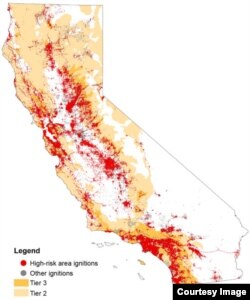Researchers have developed a long-lasting, environmentally safe substance that can prevent wildfires from spreading.
The new fluid is the creation of scientists and engineers at Stanford University in California. A report on their work was published in Proceedings of the National Academy of Sciences.
The Stanford team says the treatment could give firefighters a valuable weapon in their battle against wildfires.
Wildfires destroy an estimated 4 million hectares across the United States every year. In 2018, the federal government spent more than $3 billion on firefighting efforts, with billions more lost in property damage.
Wildfires have been a very serious problem in the western state of California. Last year, the Camp Fire, in northern California, became the deadliest U.S. wildfire in a century. State officials blamed the Camp Fire for 86 deaths. Officials say it destroyed more than 18,000 buildings, most of them homes.
The new report notes that a large majority of wildfires result from human activities. It says they often start along roadsides, in campgrounds and around electrical equipment. The researchers sought to find a substance that could be deployed to such areas to stop fires from starting in the first place.
Firefighters often use chemical fire retardants to put out fires. Fire retardants are materials that can stop or slow the spread of fires. But firefighting crews currently use them only as a kind of reactive tool. This is because the chemical treatments are not designed to stay on trees or other vegetation for long periods. They can quickly disappear because of environmental and weather conditions.
Some of the treatments being used are considered short-term solutions. They protect buildings in the path of spreading fires. But they also lose their effectiveness quickly.
The thick liquid tested by the Stanford University team was found to extend the life of the fire retardants without harming the environment.
Such a treatment could open up possibilities for firefighters to take preventive actions before fires even start, notes Eric Appel. He helped to write the new report. Appel is a professor of materials science and engineering at Stanford.
The treatment holds the promise “to make wildland firefighting much more proactive, rather than reactive,” Appel said. “What we do now is monitor wildfire-prone areas and wait with bated breath for fires to start, then rush to put them out.”
The researchers worked with California’s Department of Forestry and Fire Protection, or CalFire, to carry out experiments. In those tests, the treatment was put on vegetation in areas where fires often start.
The testing found that the material “provides complete fire protection even after half an inch of rainfall,” the study said. Under the same conditions, commonly used fire retardants provided little or no protection from fire.
The researchers said they continue to test the treatment with state transportation and fire officials. This includes one of the biggest high-risk areas for the start of wildfires: roadsides.
Alan Peters is a CalFire chief who took part in some of the test burns. “We don’t have a tool that’s comparable to this,” he said. “It has the potential to definitely reduce the number of fires.”
The development team says the treatment contains only safe materials widely used in food, drug and agricultural products. Over time, the material washes away and breaks down safely in the environment, the researchers noted.
Eric Appel said he hopes the new treatment “can open the door to identifying and treating high-risk areas to protect people’s lives and livelihoods.”
I’m Bryan Lynn.
Bryan Lynn wrote this story for VOA Learning English, based on reports from Stanford University and the Proceedings of the National Academy of Sciences. George Grow was the editor.
We want to hear from you. Write to us in the Comments section, and visit our Facebook page.
_____________________________________________________________
Words in This Story
vegetation – n. the plants and trees that grow in a particular area
monitor – v. watch something carefully
with bated breath – phr. act in an excited way
inch – n. a measurement equal to 2.54 centimeters
potential – n. having or showing the possibility of becoming or developing into something in the future
livelihood – n. the way a person earns a living











